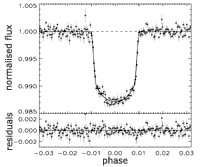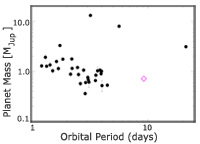CoRoT exoplanet stands out from the crowd
28 July 2008
Analysis of data from the CoRoT spacecraft along with complementary ground-based observations reveal CoRoT-Exo-4b to be a gas-giant planet whose parent star appears to rotate in sync with the planet's orbit. This object is also of interest as it occupies a previously empty region of the mass-period parameter space for transiting exoplanets.This has been reported at the Cool Stars 15 meeting at St Andrews University, Scotland and in two papers, Aigrain et al (2008) and Moutou et al (2008), which have been accepted for publication in Astronomy & Astrophysics Letters.
The parent star, CoRoT-Exo-4, was observed during the initial run of CoRoT which began on 6 February 2007 and continued for 58 days. During this period the spacecraft monitored a 1.3° by 2.6° region of the sky close to the anticentre of the Galaxy (180° away from the Galactic centre). Lightcurves for all objects observed during this run were processed and analysed for evidence of transits.
 |
|
Figure 1: The light curve of the star CoRoT-Exo-4 shows evidence for transits (sharps dips in the flux) and variability in the flux between transits. (HJD is the Heliocentric Julian Day.) (From Aigrain et al 2008). |
 |
|
Figure 2: The folded, binned light curve with the best-fit transit model (From Aigrain et al 2008). |
 |
|
Figure 3: Mass-period diagram for transiting exo-planets. The position of CoRoT-Exo-4b is indicated by the diamond shape. (From Moutou et al 2008). |
Evidence for transits
CoRoT-Exo-4 was one of a number of stars which showed evidence for a transiting body (see Figure 1). Analysis of the light curve data allowed Suzanne Aigrain and collaborators to determine a number of parameters for the system including an orbital period of
Confirmation of the planetary nature of the object
In an accompanying paper Clare Moutou and collaborators report on a series of complementary ground-based observations(*) which were performed to establish the planetary nature of the transiting body and to provide some basic parameters of the exoplanet and its parent star. They confirm that the parent star is a Sun-like star (late F-type with a mass of 1.16 solar masses and a radius of 1.17 solar radii). The exoplanet is a gas-giant planet which occupies a previously empty region of the mass-period diagram of transiting planets (see Figure 3).
In addition to the periodic dips in the CoRoT-Exo-4 light curve which are associated with planetary transits the light was also seen to vary in a manner typical of a rotating, spotted photosphere. Auto-correlation methods were applied to the light curve to deduce a rotation period for the star of
Planet and Star rotate in sync
Given the similarity between the orbital period of the exoplanet
| Table of characteristics of CoRoT-Exo-4 and its orbiting planet | |
| Exoplanet CoRoT-Exo-4b | |
| Mass (Jupiter masses) | 0.72 (±0.08) |
| Radius (Jupiter radii) | 1.10 (+0.06/-0.05) |
| Orbital period (days) | 9.20205 (±0.00037) |
| Density (g/cm³) | 0.525 (±0.15) |
| Parent star CoRoT-Exo-4 | |
| Mass (solar masses) | 1.16 (+0.03/-0.02) |
| Radius (solar radii) | 1.17 (+0.01/-0.03) |
| Rotation period (days) | 8.87 (±1.12) |
| Age (Gyr) | 1 (+1.0/-0.3) |
| Effective Temperature (Teff) | 6190 (±60) |
| Surface gravity (log g) | 4.41 (± 0.05) |
(*) Follow-up ground-based observations
The ground-based follow-up of the detection of COROT-Exo-4b was carried out with:
- SOPHIE, the cross-dispersed echelle spectrograph on the 1.93-m telescope at the Observatoire de Haute Provence (France)
- HARPS, the High Accuracy Radial velocity Planet Searcher on the 3.6-m telescope at La Silla observatory (Chile)
- UVES, the cross-dispersed echelle spectrograph on the 8.2-m Very Large Telescope at Paranal (Chile)
- the 1-m telescope at the Wise Observatory in Israel
- the 1-m Euler telescope at La Silla, and
- the 3.6-m Canada-France-Hawaii telescope
Related Publications
Aigrain, S., et al., "Transiting exoplanets from the CoRoT space mission IV: CoRoT-Exo-4b: A transiting planet in a 9.2 day synchronous orbit", accepted for publication in Astronomy & Astrophysics Letters, arXiv:0807.3767, 2008
Moutou, C., et al., "Transiting exoplanets from the CoRoT space mission V. CoRoT-Exo-4b: Stellar and planetary parameters", accepted for publication in Astronomy & Astrophysics Letters, arXiv:0807.3739, 2008
